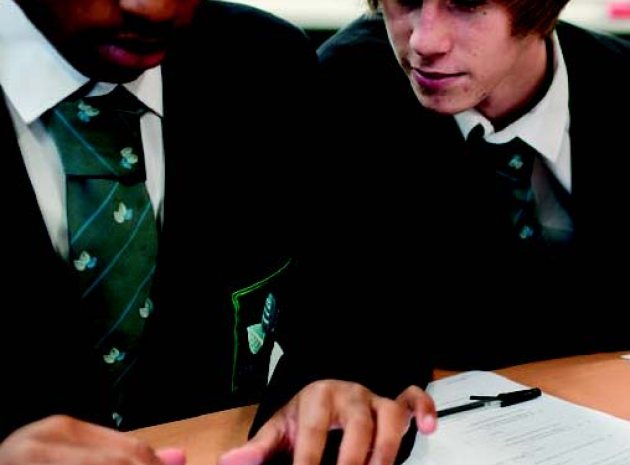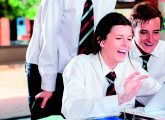School profile location: Dartford, Kent
Pupils: 970
The increasing usage of mobile technology in the education environment has long sparked debate amongst students, teaching professionals and parents. For some, its growing presence prompts concerns about children’s ability to learn, and safety and security aspects associated with such devices. For others, engaging with technology and blending it into a child’s learning environment is essential to provide them with relevant and current tools to maximise their educational experience.
One establishment that has embraced mobile technology whole-heartedly is Longfield Academy in Dartford, Kent. A key aspect during the development of the school’s overall ICT strategy was the provision of a one-to-one mobile device for all students. A term-long trial in 2010 saw 30 Year 11 pupils equipped with an iPad 1, a notebook or a laptop; the feedback was overwhelmingly positive in favour of the iPad. In September 2011, therefore, the academy launched its iPad scheme to all 970 students aged 11-18, the first large-scale deployment of this type of technology in Europe.
The scheme was developed in consultation with the eLearning Foundation charity and aims to provide all students with one-to-one access to an iPad at school and at home. Students can take part in a home-access programme where parents can lease iPads from the school. For those that don’t participate, there is a bank of iPads are available for pupils to use.
Anne Davis, is the principal at Longfield Academy. She is a keen advocate of the use of mobile devices and works closely with staff to ensure that technology enhances the educational experience. “It is important that it’s employed where it brings something extra to the lesson and is not simply used for the sake of it,” she observes, however. “We encourage a blended learning environment and iPads have allowed our teachers to deliver lessons in ways that they previously would have been unable to.”
From the outset, pupils have embraced their use and feedback is positive albeit for a few small operating issues – generally down to user error – which are easily and quickly solved.”
“Our pupils are in tune with mobile technology; they are familiar with its usage and it suits their approach to learning,” Ann continues. “As a result, they are more motivated and the quality and standard of pupil work and progress is rising. We have seen levels of collaborative working improve and the use of iPads is increasingly being developed for homework and beyond school activities.”
Staff expected pupils to be positive about the use of iPads in the classroom and sure enough, they are keen to praise the introduction. According to Daniel Olley (Year 9), “The iPad enriches learning by giving students direct access to resources, apps and iBooks that without the iPad we would be deprived of. It’s a revolution for all the students to support on-the-go learning.”
There is strong usage in English, maths and science but the presence of these mobile devices is evident across the board. It was anticipated that all lessons would make effective use of the iPads, but Anne admits that everyone has been pleasantly surprised by just how quickly staff have integrated them into their teaching and now demonstrate their creative usage. “The opportunities were immediately evident in certain areas but we have been delighted by how more creative based subjects such as music and art have utilised them,” she explains. “We are able to see the maximum benefit across the full timetable and there is further potential to develop the use of technology in lessons such as hospitality. iPads appeal to our student body; they have the cool factor but the pupils recognise that having access to them in the ways that they do is a privilege, and it is one that they do not abuse. Because they are available to everybody, there is no jealousy and we actively promote the education of appropriate usage.”
There was initial resistance to the iPad initiative amongst some members of the teaching staff but according to Anne, this can be primarily attributed to their personal lack of experience in using such technology rather than being unable to see its potential in the classroom. “Our understanding of what technology can deliver and where it can support the teaching of our pupils is continually evolving,” she points out. “It is a two-way process with students keen to share information about new apps or research tools they have discovered. It has sparked their interest in discovering what else is available to help with their school work and in part, has transferred the ownership of learning onto the children and created a desire to improve their own knowledge.”
The academy is keen to develop its technology strategy for encouraging the use of handheld devices for learning. As part of this, it has invested in GCSEPod, a curriculum-wide range of teacher-written audio visual revision and learning materials delivered as podcasts that students can stream onto their own phones, iPods and tablet computers (an app is also now available). “GCSEPod usage in the school is still in its early stages as it was only introduced at the beginning of 2012,” says Anne, “but we are aware of the success of this type of revision tool at other schools and its potential across a broad spectrum of subjects is very clear to see.”
Getting parental buy-in is critical and according to Anne, they have embraced the introduction of technology and been largely positive about the iPad leasing scheme. “They want to ensure value for money and see that the iPads are being regularly used and forming an important part of lessons right across their child’s timetable. The take-home scheme allows pupils to share their teachings with their parents and the iPads are being used by the whole family which is an excellent way to encourage collaborative learning.”
Does the introduction and development of mobile technology have a positive effect on the results achieved as well as enhancing pupils day-to-day learning experiences? Yes, according to Anne, with the school’s recent GSCE results seeing an improvement of 10 per cent in the number of students achieving five A-C grades when compared to the previous year. However, Anne is keen to stress that this success is not solely down to the introduction of mobile technology or revision resources, with a new building, one-to-one coaching and revision master classes all contributing.
So, what advice would Anne Davis offer to other educational establishments looking at mobilising technology within their schools? “Develop a clear strategy and vision for your programme and get everyone involved in what you are aiming to achieve,” she suggests. “Understand the learning culture that exists and establish how many staff and students already use and have access to the technology you are looking to introduce. Finally, make sure you have a robust reporting and evaluation system in place so you are continually learning and making developments based on your experience.”











“The quality and standard of pupil work and progress is rising…”